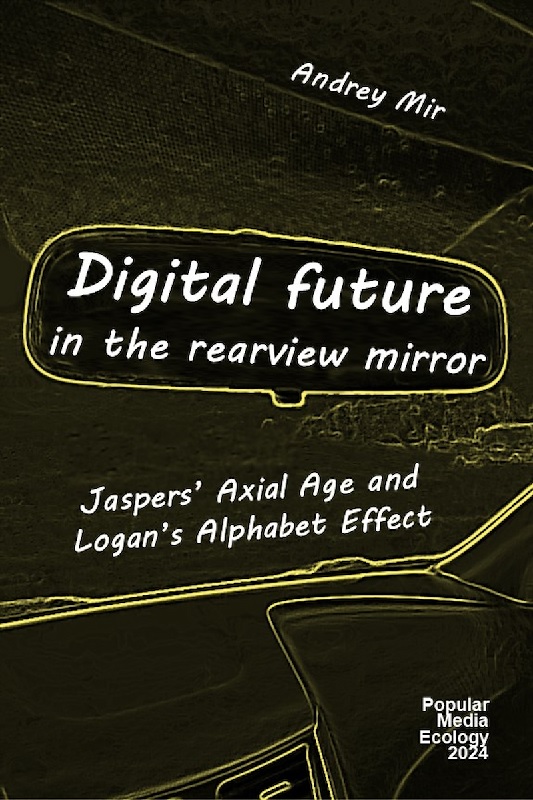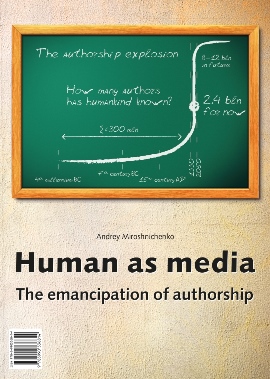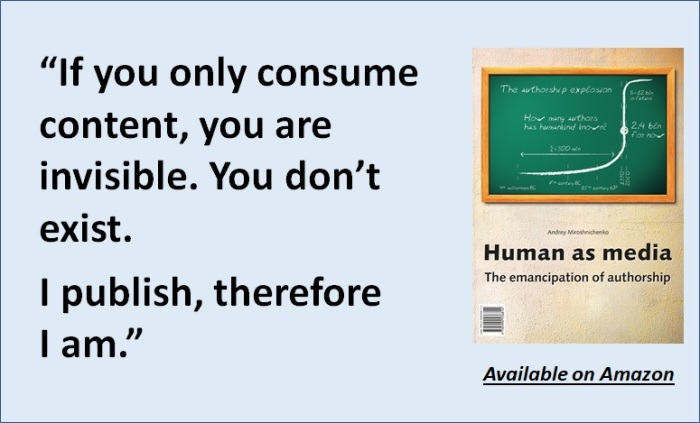Historical periods have a distinctive temporal characteristic in their progression: each following historical period was shorter than the previous one. History accelerated because the change of media forced it. An excerpt from Digital Future in the Rearview Mirror: Jaspers’ Axial Age and Logan’s Alphabet Effect.
…As was the case with television in the time of McLuhan and Postman, digital media turned the attention of media ecologists, once again, to past media epochs in a search for patterns and analogies. But now, thanks to Innis, McLuhan, Postman, and others, we are better equipped to see the dependencies between the development of society and the evolution of media.
Historical periods have distinctive features defined by media. Give a media ecologist information about what medium is used by the Martians – carved stones, inks on animal skin, or neurotransmitters – and we will describe some fundamental principles of the current Martian civilization. But historical periods also have a distinctive temporal characteristic in their progression: each following historical period was shorter than the previous one. History accelerated because the change of media forced it.
Rough but simple and obvious calculations make apparent the pace of this acceleration. The sensory/cultural mode of orality, maintained by respective media devices (speech, implements), lasted about three to five thousand generations of humans[1]. Writing enclosed 170 generations. Print dominated for about 15 generations. Electric media, starting with the telegraph, then radio and TV, has been affecting the sensorium and society for 5 generations.
This progression gives us a numerical sequence “5000 – 170 – 15 – 5”. It resembles a countdown. On the count of “one”, the length of the era will align with the lifespan of the generation.
In “Human as media”, I suggested the notion of the “pivotal generation” – the generation whose lifespan, for the first time in history, became longer than a technological era. The “pivotal generation” consisted of people born in the middle of the 20th century. Their life encompassed two or even three eras – agricultural, industrial, and post-industrial. A typical feature of this generational shift in most countries has been grandparents starting their lives in agricultural or industrial settings and their grandchildren belonging to digital migrants or digital natives.
After the pivotal generation, historical periods measured by dominant technology have started offsetting each other within the lifespan of a generation. It means that every one of us experiences the arrival of a medium that would have made its own epoch in the good old times: the internet, cellphones, tablets, smartphones, social media, VR, generative AI, and brain-machine interfaces… The historical explosions of new media, once quite rare and distinctive, have now merged into the rumble of a rocket launch. Its thrust stuns the human sensorium and disturbs the social ecosystem, which no longer has enough time to achieve a new equilibrium after being disturbed by the previous new medium.
The acceleration of historical time means that increasingly more “media events” (and events in general) happen in a time period. This gives us another description of the shortening of the historical era down to the size of a lifespan and below. The accelerating increase of events per a period is graphically represented by the exponential growth curve. Such exponential growth of events is, essentially, a portrait of the Singularity: the Singularity happens on the “vertical end” of this curve.
If the count “one” in our countdown of shrinking media eras gives us the pivotal generation (for whom the era shorter than a lifespan), then what will happen on the count “zero”?
The Singularity, of course. The fact that eras have already shrunk below the length of a generation lifespan means that the “Singularity is near”[3] indeed.
It is even possible to calculate the point “zero” on the historical timeline for the countdown “5000 – 170 – 15 – 5” that represented the lengths of the eras dominating by speech, writing, printing, and electricity, respectively. The progression indicates that the length of the digital era will be 1–1.5 generations, which sets up the “point zero” sometime in the 2040–2050s (assuming that the digital era started, roughly, in 2000).
This is pure speculation and the epitome of media conspiracy, so to speak. However, the logic of the shrinking of historical eras (or the accelerating of historical time) is implacable. One can consider other milestone media inventions that have defined the pace of media evolution, including various means of transportation such as walking, horses, sailing, steam engines, internal combustion engines, and jets. The lengths of eras dominated by those transportation media will give the same progression of shrinking the eras (or accelerating the historical time). The math behind this progression might not be solid, but media ecology as a “field of inquiry” (Strate) works with pattern recognition, not with exact calculations. This countdown will also point at the same mid-21st-century mark as “point zero” of the Singularity countdown. This is within the reach of one generation, i.e., us or our children. Watching the development of AI and cognitive interfaces will help to specify the exact date.
A chapter from Digital Future in the Rearview Mirror: Jaspers’ Axial Age and Logan’s Alphabet Effect.
See also books by Andrey Mir:
- Digital Future in the Rearview Mirror: Jaspers’ Axial Age and Logan’s Alphabet Effect (2024)
- Postjournalism and the death of newspapers. The media after Trump: manufacturing anger and polarization (2020)
- Human as media. The emancipation of authorship (2014)



[1] If we agree that speech and implements emerged 100–150 thousand years ago, the latest time-mark in the consensus of paleoanthropologists. Other estimates move the emergence of speech and tools as far in human history as 2 million years ago. This makes the acceleration of historical time even faster.
[2] Miroshnichenko, Andrey. (2014). Human as media. The emancipation of authorship.
[3] The Singularity Is Near: When Humans Transcend Biology is a 2005 book by Ray Kurzweil. He predicted the advent of the Singularity in 2045.
Categories: Digital Future in the Rearview Mirror, Digital orality, Future and Futurology, Human as media book, Media ecology, Singularity and Transhumanism



Leave a comment